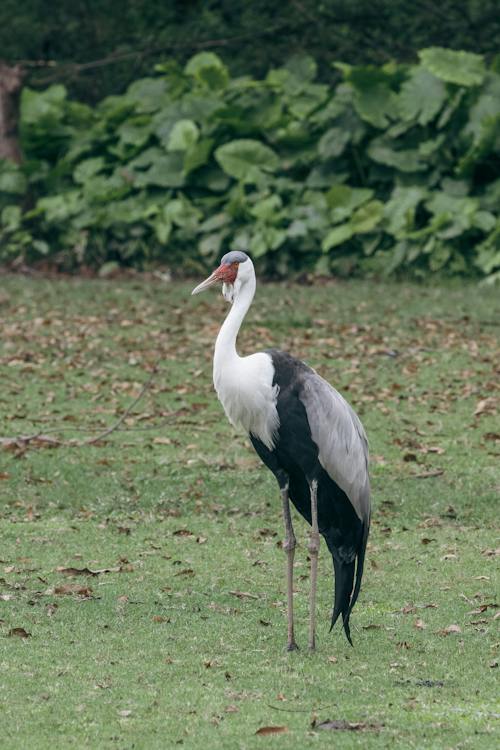It is a grayish, red-faced bird that got its name from the conspicuous, dangling white wattle from its throat. It is the largest and rarest crane species in Africa, relying heavily on water areas, making it a vital environmental indicator species of thriving wetlands. While it is generally silent, it has a unique, quick, and high-pitched ‘koorok-kreek’ call.
Read further to know more about the Wattled Crane.
What is a Wattled Crane?
Wattled crane (Grus carunculata) is a large bird found in sub-Saharan African. It is often classified in the monotypic genus Bugeranus. It is a diurnal bird that spends most of its day foraging and using its long bill to dig wetlands and soft soil for food. Birds from this species are gregarious even outside the breeding season, gathering in flocks of 10 to over 85 birds.
Its seven levels of classification are as follows:
Kingdom: Animalia
Phylum: Chordata
Class: Aves
Order: Gruiformes
Family: Gruidae
Genus: Grus
Species: Grus carunculata
Wattled Crane Physical Description
Wattled Cranes are easily recognizable through the flap of skin hanging from their skin called a wattle. It is only a distinct physical feature, as it is indicative of their moods, either shrinking when they are afraid or nervous or elongated if they are thrilled or excited.
Wattled cranes are the largest of all the crane species in Africa, having an average length of 69 inches or 175 centimeters, and an average of 8300 to 8500 grams for males, and 7100 to 7900 grams for females.
Adult wattle cranes boast grayish upperparts and wings. Its flight feathers are on a darker shade of gray or often blackish. Their second flight feathers are longer, stretching beyond their tail and almost reaching the ground. Their upper backs are also on a darker gray tone.
Wattled cranes have a white breast and neck, which contrasts their black underparts and dark gray upper bodies. Their forecrown and forehead are also gray.
A grainy patch of red facial skin surrounds the bill based and the lores, reaching until the front of their distinct feathered wattles. Their bill is long, reddish-brown colored. Meanwhile, their iris are orange to reddish. Toes and legs can be dark gray to black.
Males and females look similar. Their juveniles or immature birds have brown plumage, sans the red, bare skin on their faces, while their wattles are also not fully developed yet. Their forehead and crown are whitish, and flight feathers are relatively shorter.
Where can they be spotted?
Wattled cranes rely heavily on wetlands, such as river basins, and permanent or seasonal wet areas. They occur in Africa’s sub-Saharan countries, namely Angola, DR Congo, Botswana, Ethiopia, Mozambique, Malawi, Namibia, Tanzania, Zambia, South Africa, Lesotho, Zimbabwe, and Guinea-Bissau. These birds breed in shallower wetlands with sedges.
Interesting Facts You Should Know About the Wattled Crane
Like all other cranes, wattled cranes are omnivorous. While they love to munch on rhizomes and tubers from water lilies, they occasionally eat grass, seeds, and aquatic insects, or anything that they can find from the mud using their long bills. Amphibians, snakes, and snails are no exception, should they come along the way of these birds. They are diurnal, meaning they forage during the day.
Wattle cranes are pretty gregarious and renowned for their sociable demeanor. They can be seen in a flock of 10 to over 85 individuals. These birds are often seen interacting with other animals, such as the gooses and antelopes.
These birds are monogamous and form bonds with their partners, often lasting their lifetime. Nest building is a part of their courtship antics, and other elegant displays, such as running, jumping, bowing, and even tossing specific vegetative items.
Their breeding season usually relies on the status of water levels. For some areas, it can be from July to August, while April to October in southernmost regions. The female will lay one to two eggs around three weeks after building a nest from aquatic vegetation they get from marsh banks.
Both parents will incubate the eggs for around 33-36 days. Once the chicks hatch, they are already able to walk and swim, following their parents to acquire foraging skills. However, only one chick usually survives, as only one is reared while the other is neglected. The surviving chick will fledge after reaching 3-4 months old, the longest fledging period among all cranes species. The chick will stay with its parents until the start of the next breeding season.
Wattled cranes are known for their incredible communication techniques, and the elegant duets they do with other birds from their species. Even juveniles are known to produce different sounds, ranging from chirps and purrs to bond with their family or ask for food.
Cranes have been recognized for their excellent communication techniques and the beautiful duets that they stage with others of their species. Little ones use a range of purrs and chirps to bond with their parents and to demand food.
Since wattle cranes are pretty rare, the specific details about their life expectancy are yet to be fully supported. However, it is deemed that they can reach between 20 to 30 years of age in the wild. Moreover, their large size allows them not to fall prey to most predators, though, jackals often attack helpless chicks.
The most severe threat to their population is the loss or degradation of their wetland habitats. Water levels go down due to increased human activities, such as agriculture, irrigation, dam building, and industrialization. Other threats for their survival include accidental poisoning, frequent crashes to power lines, egg collection, and killing adults for food.
WILDLIFE PARKS AND RESERVES WHERE THIS SPECIES IS FOUND:
ZAMBIA
ZIMBABWE
BOTSWANA
BOTSWANA BIRDS | SOUTH AFRICA BIRDS
NAMIBIA BIRDS | ZAMBIA BIRDS | ZIMBABWE BIRDS
